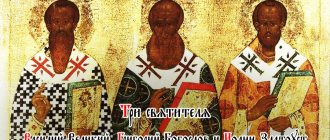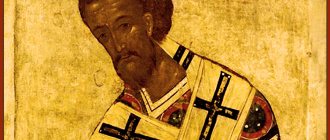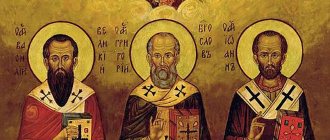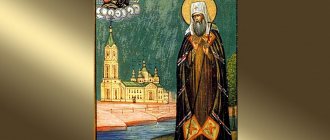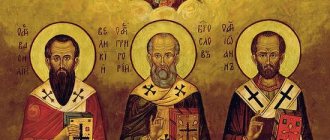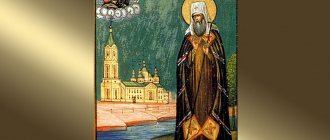Saint Basil the Great. Biography
Saint Basil the Great was born around 330 in Caesarea in Cappadocia. His parents were of noble birth, and were also distinguished by their zeal for the Christian faith. His grandparents suffered during the persecution of Emperor Diocletian, and his uncle was a bishop, as were two brothers - Gregory of Nyssa (c. 335–394) and Peter of Sebaste . Vasily's father was an orator and lawyer and wanted Vasily to follow in his footsteps. Basil received an excellent education in Caesarea and Constantinople, and then studied at the Athens Academy. In it he met Gregory the Theologian (329–389).
Upon his return to Caesarea, Basil became involved in secular affairs, but thanks to the influence of his pious sister Macrina (324 (327 or 330)–380), Basil began to lead a more ascetic life and eventually left the city with several friends and settled on family lands in Ponte. In 357, Basil went on a long journey through Coptic monasteries, and in 360 he accompanied the Cappadocian bishops to the synod in Constantinople. Shortly before the death of the Caesarea bishop Diania, Basil was ordained a presbyter and became an adviser to Bishop Eusebius, who succeeded Diania after his death. Eusebius did not like Vasily’s strict ascetic life, and Vasily decided to go into the desert, where he began to establish a monastic life.
The rise to power of the Arian emperor Valens (328–378) and the growing oppression of Christians led Eusebius to seek the help of the active and diligent Basil. In 365, Basil returned to Caesarea and began to govern the diocese. He wrote three books against the Arian heresy, preaching "three hypostases in one essence." Despite the opposition of a number of bishops, after the death of Eusebius in 370, Basil took over as Metropolitan of Cappadocia and began to eradicate Arianism in Asia Minor. Basil's efforts to eradicate Arianism brought him into conflict with Valens. During the emperor's trip to Cappadocia, the bishop categorically refused to recognize the correctness of the Arian teachings. In response, Valens divided Cappadocia into two provinces, which reduced Bishop Basil's canonical territory and undermined his position in the Church. Nevertheless, Vasily managed to promote his comrades Gregory of Nyssa and Gregory the Theologian to the place of bishops of key cities. At this time, the struggle for the patriarchal throne in Antioch began, on which Basil did not want to see the Nicene Paulinus, fearing that an excessive exaggeration of the unity of God was fraught with the heresy of Sabellianism.
Emperor Valens died at the Battle of Adrianople (378). Bishop Vasily's health was undermined by his ascetic lifestyle. He died on New Year's Day 379. Saint Basil left us many theological works: nine discourses on the Sixth Day, 16 discourses on various psalms, five books in defense of the Orthodox teaching about the Holy Trinity; 24 conversations on various theological topics; seven ascetic treatises; monastic rules; ascetic charter; two books about Baptism; a book about the Holy Spirit; several sermons and 366 letters to various persons.
Library of the Russian Faith The Life and Miracles of Our Father Basil the Great, Archbishop of Caesarea in Cappadocia. Great Menaion of Cheti →
Read online in original
Miracles and good deeds
The life of Basil the Great is surrounded by legends. Orthodox believe that the man witnessed and performed several miracles. One day, a woman who was being oppressed by her boss turned to the saint. But the offender responded rudely to the letter written by Vasily. Then the great saint prophesied to him that he himself would soon be saved from the wrath of his superiors. And indeed, after a while the chief fell into disgrace with the king.
Good deeds of Basil the Great
During the Persian War, Vasily selflessly prayed before the icon of the Most Holy Theotokos, at whose feet was depicted the Great Martyr Mercury, a warrior with a spear. The man asked the saints to prevent Julian the Apostate from returning alive from the war. Suddenly Mercury disappeared, and when he appeared, blood was dripping from his spear. Later, messengers brought the news that Julian had been seriously wounded in the war.
Basil had an unusual gift: during the liturgy, the golden dove hanging over the holy altar shook three times, testifying to the appearance of the Holy Spirit. But one day the bird did not give a sign, and Vasily thought about it and realized that the reason was the deacon, who dared to look in the direction of a beautiful woman during the service.
Golden Dove of Basil the Great
The priest put the deacon on strict penance, and ordered a partition to be built in front of the altar so that women could not look at him during the service. Since then, the dove has not ceased to announce the descent of the Holy Spirit.
Another legend says that Vasily managed to avoid exile by divine providence. On the day of the Epiphany of the Lord, King Valens appeared in the church where he served. Seeing the beauty of the decoration and order in the temple, he was so delighted that he was imbued with affection for the holy saint.
However, having gone home, Vasily’s enemies persuaded the ruler to expel the fighter against the Arians. During the signing of the corresponding decree, the chair under Valens swayed and the cane used to sign the signature broke. After the third cane cracked, the emperor became frightened and destroyed the sentence.
Basil the Great and the dove
Vasily gained fame as a kind man, ready to help those in need, even if he himself faced punishment. There is a well-known story about the rescue of the young and rich widow Vestiana, whom the eparch Eusebius tried to forcefully marry to a dignitary. The girl did not want to lose her widow’s purity and rushed to Vasily with pleas for help.
The bishop managed to send the poor man to a nunnery, when Eusebius’s messengers immediately arrived demanding the handing over of the rebellious fugitive. Then Vasily was caught in adultery and the bedchamber was searched. The angry eparch promised to send the saint to great torment. Having learned that they wanted to punish Vasily, the people rushed to the palace of Eusebius with weapons. As a result, the saint returned to his own monastery alive and unharmed.
Veneration of St. Basil the Great
Saint Amphilochius, Bishop of Iconium (c. 340–394), in his funeral homily about Saint Basil said:
He has always been and will be a most saving teacher for Christians.
For his services to the Church of Christ, Saint Basil is called the Great and is glorified as “the glory and beauty of the Church,” “the luminary and eye of the universe,” “the teacher of dogmas.” Saint Basil the Great is the heavenly patron of the enlightener of the Russian Land - the holy Equal-to-the-Apostles Grand Duke Vladimir, in holy baptism Vasily. Prince Vladimir revered Saint Basil and erected several churches in his honor in Rus'. Many Russian rulers were named after Basil the Great at baptism, in particular, Vladimir Monomakh (baptized Vasily), Vasily I, Vasily II. Saint Basil the Great, along with Saint Nicholas the Wonderworker, is especially revered by the Russian people. A particle of the relics of St. Basil is located in the Pochaev Lavra. The honorable head of the saint is kept in the Lavra of St. Athanasius on Athos, and his right hand is in the altar of the Church of the Resurrection of Christ in Jerusalem. The memory of St. Basil the Great is celebrated on January 14 (January 1, old style) and February 12 (January 30, old style) - in the Cathedral of the Three Hierarchs.
Scriptures of Saint Basil
The main theological works of Vasily are:
- Treatise "On the Holy Spirit" (Lat De De Spiritu Sancto), a clear and edifying work, written in 363 or 364. It proves the divine nature of the Holy Spirit.
- Three books of objections to Eunomius Cyzicus. The first three books of the Refutation are his work; the fourth and fifth books belong to Apollinaris of Laodicea and probably to Didymus the Blind.
- “Monastic rules”, characterized by common sense and lack of formalism.
He was also a famous preacher who conveyed to people the meaning of divine sacraments, deciphering Biblical truths.
Troparion, kontakion and canon to St. Basil the Great
Troparion, tone 1:
To the whole2 earth your message has come, as your word has come, and you have taught 3si2, and 3 the nature2 of those who exist. humanely decorated є3сi2. This is a great meaning, and the Lord, pray to God to save our people.
Kontakion, tone 4:
The Kwi1cz pillar of immovable churches, giving everyone the inestimable earthly wealth, was imprinted by your disciples, your heavenly teacher.
Library of the Russian Faith Canon to St. Basil the Great →
Read online
Description of the icon
The icon of Basil the Great depicts the face of this saint, to whom it is customary for hermits, teachers, musicians and other artists to turn to for help. The icon helps when a person plans to build a new building. Also, the icon of Basil the Great helps parents if their children do not study well. Then problems with studies will be resolved positively.
In addition, the icon of Basil the Great will help:
- better understand the Christian faith and overcome self-doubt;
- find peace of mind and enlightenment;
- get help in overcoming illnesses and everyday difficulties;
- be confident in facing new challenges.
Folk traditions on the day of St. Basil the Great
The eve of Vasilyev's Day was popularly called Vasilyev's evening. Among the northwestern Slavs, he received the name “generous”, “generous”, “rich”, because on this evening they took out the best from the storerooms; in central and southern Russia - “Avsen”, “Ovsen”, “Usen”, “Tausen”. The favorite Christmas pastime for young people was fortune-telling; they were considered the most accurate and valid just before the New Year, on Vasiliev's evening. All types of fortune-telling were dedicated to this day, despite the fact that pious people considered this a great sin. Almost all methods of fortune telling have one goal - to find out how soon, where and to whom they will marry (or who they will marry) and how life will turn out in someone else's family.
Saint Basil the Great was revered as the patron saint of pigs, which is why people also called this holiday the pig holiday. On the holiday, they slaughtered cattle, stabbed the so-called “Caesaret” piglets (named after Basil the Great, Archbishop of Caesarea), so that the table would be hearty, meaty, and they said: “A pig and a boar for Vasily’s evening.” One of the main dishes was a stuffed pork head: “On Vasily’s Day, a pig’s head on the table!” “The pig is not a clean animal,” one can hear among the people, “but God has nothing unclean: the fire burns the bristle pig, but Basil of the winter will sanctify it!” Roasted Caesaretian pig is considered a common property: all fellow villagers can come and eat it, and each of those who come must bring at least a little money, which is given to the owner, and the next day is transferred to the parish church and goes to the clergy. Custom requires that the Caesaret pig must be roasted and served whole (uncut), at least in size it resembles a large pig. Before eating, the eldest in the family raises the cup with the pig up to three times, saying: “So that the pigs piggy, the sheep lamb, and the cows calve.”
According to folk custom, a rich table on Vasily’s Day will provide the owner with prosperity for the whole year
Also, kutya was always served on the table. Unlike kutya on Christmas Eve (“lenten”) and Epiphany (“hungry”), it was “rich”; cream, butter, almonds, and walnuts were added to it. The table was not inferior in its assortment of dishes to the Christmas feast. Many customs were associated in the popular imagination with Vasilyev's evenings. And now in some places such customs as cooking “Vasil porridge”, sowing grain or going from house to house are observed.
Painting by Alexander Mitsnik
After the festive dinner, there was a tradition of going to neighbors and friends and asking each other for forgiveness. Vasily's Day was especially popular among young people. They could woo again if they had previously been refused. On this day, children liked to scatter grains of spring bread throughout the huts: “sowing” was a kind of ritual. The housewives then collected the grains and stored them for sowing. Gardeners also especially prayed to St. Basil the Great, asking him to save fruit trees from pests. In some places there was a custom to shake off trees that evening with the saying: “As I shake off the white fluffy snow, so Saint Basil will shake off every worm-reptile in the spring!”
Peculiarities of addressing an icon
Depending on what kind of help a believer needs, one can turn to the face of St. Basil:
- for blessing in charitable deeds;
- for successful completion of land cultivation and obtaining a generous harvest;
- so that a difficult situation ends happily, and the trouble leaves the house;
- to protect against illnesses, to ensure good luck in life, to support the needy and suffering.
Almost 230 churches in honor of St. Basil have been built around the world. To read a prayer, it is sometimes allowed to use not the icon itself, but its photographic image.
Saint Basil the Great. Icons
According to the iconographic original of the 16th century, St. Basil the Great was depicted in frescoes and icons wearing a light cross-haired phelonion, with his right hand blessing the people, and holding the Gospel in his left. Initially, Basil the Great was depicted frontally, chest-to-chest, as on the 7th century icon. from the monastery of the Great Martyr Catherine in Sinai. Later, full-length images of the saint appeared. On the icons of the 11th century, Basil the Great is depicted bowed in prayer, with an unrolled scroll in his hands.
Saint Basil the Great. Fresco. Serbia (Studenica). 1209
Basil the Great. From the Deesis rank. OK. 1486 Museum named after. Andrey Rublev
Saint Basil the Great. Fragment. Image by Theophanes the Greek. 1405
At the end of the 11th century, the celebration of the memory of the Three Hierarchs (Basily the Great, Gregory the Theologian and John Chrysostom) was approved in Byzantium. In this regard, joint images of the Three Hierarchs became widespread. In Ancient Rus', festive icons of the Three Hierarchs became widespread from the 15th century, often as part of menain tablet icons, for example, “Trinity” (2nd quarter of the 15th century), “Sophia” from Veliky Novgorod (late 15th century).
Three saints: Basil the Great, John Chrysostom and Gregory the Theologian. Icon. Beginning of the 17th century Church-Archaeological Cabinet of the Moscow Theological Academy
In the Byzantine art of the Palaiologan period, compositions appeared that revealed the theme of the teaching of the holy fathers, for example, “The Conversation of the Three Hierarchs” or “The Blessed Fruits of the Teaching” in the frescoes of the Church of the Archangels in Lesnov, Macedonia (1347–1349). Basil the Great sits behind a music stand with a cross-shaped base, from which streams of water emanate, i.e. "river of learning" Such iconographic images of the saint appeared in Rus' in the 16th–17th centuries. entitled “Conversation of Basil the Great, Gregory the Theologian and John Chrysostom”, “Teaching”, or “Good Fruits of Teaching”, for example, in the mural of the Cathedral of the Nativity of the Virgin Mary of the Ferapontov Monastery (1502).
Conversation between Basil the Great, Gregory the Theologian and John Chrysostom (“Good Fruits of the Teaching”). Savin Nikifor Istomin. Beginning of the 17th century State Tretyakov Gallery, Moscow
In Moscow icon painting, illustrations of the life of Basil the Great are more common. The Russian face list of the Life of Basil the Great of the 3rd quarter of the 16th century is distinguished by its exceptional wealth of iconographic subjects (225 sheet miniatures). from the collection of M. A. Obolensky. Russian monuments of the 17th century. were distinguished by an increase in the number of hagiographic episodes and great decorativeness.
Celebrating Vasily's name day
The celebration of the Synaxy of the Three Great Doctors of the Church, or the "Three Companions" as they were called, originated in 1100 during the time of Emperor Alexis Comnenus. A great quarrel, according to which one of these three theologians was recognized as the most important, then divided the people of Constantinople. Patriarch John, appointed as arbitrator, resorted to fervent prayer to help find a solution. Vasily, Gregory and Chrysostom appeared to him in a dream and told him that they were equal before God, and that each of them had his own personality and genius. January 30 is a holiday dedicated to all three saints of the Orthodox Church.
February 12 is also the day when the Trinity of Saints is venerated - Basil, Gregory and John. All of them made enormous efforts to develop theological science, interpreted the meaning of the sacred scriptures, and prevented a split in the church. Vasily himself is commemorated on January 2.
Temples in Rus' in the name of St. Basil the Great
The first temple, built by Prince Vladimir in Kyiv on the site of a pagan temple, was consecrated in the name of Basil the Great. Prince Vladimir also erected the Church of St. Basil in Vyshgorod, where the passion-bearing princes Boris and Gleb were originally buried. In the 12th century, churches were built in the name of Basil the Great in Kyiv, Novgorod, Ovruch and in Smyadyn near Smolensk. In the XIII–XV centuries. churches in honor of Basil the Great were built in Tver (before 1390), Pskov (before 1377) and in other cities.
The church in the name of St. Basil the Great in Ovruch (Ukraine) is part of the complex of St. Basil's Convent (UOC MP). The temple was built in 1190 by Prince Rurik Rostislavovich (d. 1212). The construction of the church was led by the architect of Ancient Rus' Peter Miloneg. In 1321, the Vasilyevskaya Church in Ovruch was almost completely destroyed by the Lithuanians, restored in 19070–1909 by the famous architect A.V. Shchusev. Fragments of ancient Russian frescoes have been preserved in the temple.
In the name of St. Basil the Great, a temple was consecrated in the city of Vladimir-Volynsky (Ukraine). The exact date of construction of the church is unknown. According to researchers, the church building dates back to the 70–80s of the 13th to mid-14th centuries. The first documentary information about this monument dates back to 1523. In 1695 the church was in disrepair, and it remained the same in the 18th century. The monument was rebuilt and completed more than once. The interior was decorated with frescoes, whitewashed at the end of the 17th century. Significant works that changed its original appearance were carried out in 1900–1901. designed by architect N.I. Kozlov.
In the name of St. Basil, the Church of Vasily on Gorka in Pskov was consecrated. The wooden temple on the site of the stone one was built in the 14th century on a hill rising in a swampy area in front of the Zrachka stream. In 1375, a wall of the Middle City was built along the bank of the stream and the Vasilyevskaya Tower was erected opposite the church, over which a belfry was built. In 1377 the temple was painted. In 1413, a stone temple was erected on the site of the wooden church. The end of the 15th century and the 16th century are a period of prosperity; at this time, chapels and a gallery were added to the temple. At the beginning of the 16th century, the revered temple icon of the Tikhvin Mother of God was painted.
In the Tverskaya Yamskaya settlement of Moscow there once existed a church in the name of St. Basil. The exact time of construction of the temple is unknown. The first mention of the church of Basil, Bishop of Caesarea, in the sources is found in the census of 1620–1621. This church was wooden, cut down "kletski". In 1671, all the buildings of the Tverskaya Yamskaya Settlement were destroyed by fire. In 1688, construction began on the stone Church of Basil of Caesarea. In May 1934, the temple was closed and destroyed.
In Kyiv on the street. Victims of the Revolution (formerly Three Saints) until the 30s. XX century there was a church in the name of three saints - Basil the Great, Gregory the Theologian and John Chrysostom. Previously, this church was called Vasilyevskaya. It was built in the early 80s. XII century Prince Svyatoslav Vsevolodovich at the princely courtyard and consecrated in 1183: “The Church of St. Basil, which stood in Kyiv at the Great Courtyard, was sacred.” After the Mongol invasion, the church was built only in the 16th century. was restored, and in the middle of the 17th century. burned down. At the end of the 17th century. the church, which stood without vaults, was again restored. In 1935-1936 it was dismantled.
The lost temple of St. Basil the Great in Kyiv. Drawing from the magazine “Zodchiy”
Original icon
The icon of Basil the Great, a photo of which can be found in this article, is an image of the sixteenth century. In the original, the Saint is dressed in a light-colored veil, holding the Gospel in his left hand. The right hand gesture blesses all Christian believers.
This icon is intended for the altar; the face of the Saint is depicted in a frontal chest plan.
There is also an icon from the eleventh century, where the Holy Teacher was depicted bowed in prayer. Vasily's hands hold an open scroll. There are also miniature compositions that depict episodes from the life of the saint.
Many iconographies date specifically from the Middle Ages. Tsar Ivan the Terrible revered this Saint; during his reign, a large number of icons of St. Basil the Great.
There is an image of the Saint holding Jesus in his arms. This work is considered symbolic for the Communion procedure.
Old Believer churches in the name of St. Basil the Great
In the name of St. Basil the Great, the Church of the Russian Orthodox Church in the city of Solikamsk, Perm Territory, was consecrated. The Old Believer Church was built in the early 1990s under the care of the Krechetov family, consecrated in 1995, and the bell tower built in 1999. In 2000, the temple, excluding the bell tower, burned down and was rebuilt.
In the village Zolotilovo, Ivanovo region in 1895-1915. A Russian Orthodox Church church was built in honor of St. Basil the Great. The church is currently abandoned.
In 1854 in the southeast of Romania in the village. Sarikoy built the RDC Church in the name of St. Basil the Great.
Death
By the time the opportunity arose to take advantage of political changes in the state, the ascetic lifestyle had completely exhausted Vasily’s body. The man died on the first day of 379, having served in the temple for 8.5 years.
Relics of Basil the Great
According to legend, before his death, Basil the Great first baptized a Jewish novice, then addressed his disciples and flock with edifying words not to leave the church until 9 o’clock yesterday. He prayed to God, giving praise for such a rich and righteous life, and gave up his ghost. Representatives of different faiths were seen at the funeral - Christians, Jews, and even pagans. Vasily was canonized soon after his death.
Prayer to Saint Basil
O great one in the hierarchy, God-wise teacher of the universe, blessed Father Basil! Great are your deeds and labors, which you have accomplished for the glory of the Holy Church: you have been a steadfast confessor and a lamp of the faith of Christ on earth, illuminating the faithful with the light of God, scorching false teachings, and proclaiming the word of saving truth to the whole world. Now, having great boldness in heaven towards the Holy Trinity, help us, who bow to you with humility, to firmly and unchangeably preserve the holy Orthodox faith until the end of our lives, and keep us from lack of faith, doubt and hesitation in faith, so that we will not be seduced by those who oppose God and soul-destroying teachings in words. The spirit of holy zeal, with which you blazed, O glorious shepherd of the Church of Christ, kindle with your intercession also in us, whom Christ has appointed to be shepherds, so that we may diligently enlighten and confirm in the right faith the verbal flock of Christ. Ask, O merciful saint, from the Father of lights and everyone, every gift that is useful to everyone: growth for the infant in the Passion of God, chastity for the young, strengthening for the old and weak, consolation for the grieving, healing for the sick, admonition and correction for the erring, intercession for the offended, protection for orphans and widows. , to those who are tempted, grace-filled help, to those who have departed from this temporary life, to our fathers and brothers blessed repose. To her, Holy One of God, look mercifully from the abodes on high upon us humble ones, overwhelmed by many temptations and misfortunes, and lead those who are devoted from the earth to the heights of heaven. Grant us, most good Father, your archpastoral and holy blessing, so that in this new summer and at all other times of our lives we will live in peace, repentance and obedience to the Holy Orthodox Church, diligently doing the commandments of Christ, fighting the good fight of faith, and so We will reach the Kingdom of Heaven, where with you and all the saints we vouchsafe the Holy Trinity, Consubstantial and Indivisible, to sing and glorify forever and ever. Amen.
The prayer is long, but effective. It is better to read it in front of the icon of Basil the Great.
Gravestone memorial
What does Basil the Third have to do with the icon of Basil the Great? This shrine is the oldest shrine in comparison with other images. It became a funerary shrine during the burial of Prince Vasily the Third. It is kept among other icons in the tombstone iconostasis. Location – royal tomb, Archangel Cathedral, Kremlin.
The icon was immediately located above the tomb of Vasily the Third. Researchers note that the face on the icon is very similar to the image of the emperor himself. The work dates back to the sixteenth century.
